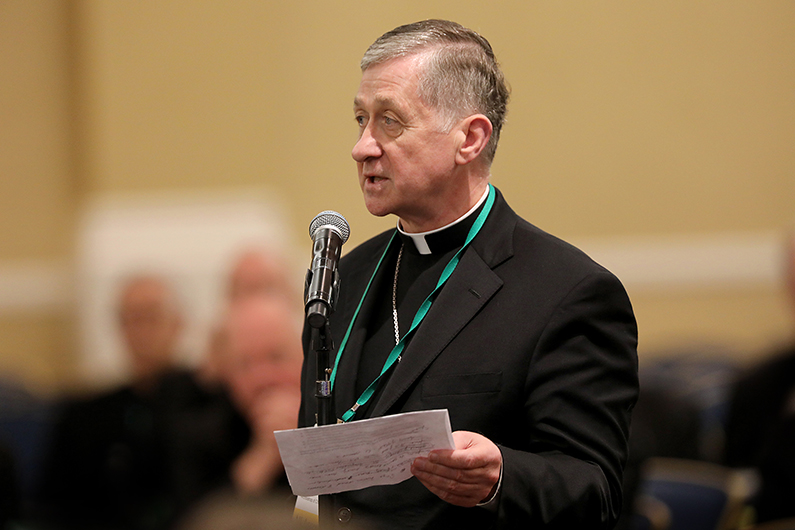Archdiocese Releases Review of Abuse-prevention Policies, Procedures
By Michelle Martin
A review of the Archdiocese of Chicago’s policies and procedures on the prevention of sexual abuse of minors, the way the archdiocese reports and investigates allegations and how it supports victims showed many strengths, as well some areas that could be improved. Monica Applewhite, an internationally recognized expert on sexual abuse and the development of policies and procedures to deal with it, was hired last year to evaluate what the archdiocese has done and could do better. The review was not sparked by any particular incident in the archdiocese, Applewhite said. Rather, she was asked to look at the systems that were in place to prevent and respond to clerical sexual abuse and suggest any further steps the archdiocese can take. William Kunkel, the archdiocese’s general counsel, said the archdiocese has asked outside experts for help evaluating and strengthening its sexual abuse prevention and response policies since they were first instituted in 1992. However, this was the first time a U.S. Catholic diocese has asked Applewhite for this kind of review, she said. She has worked with other dioceses on developing and implementing policies, and from 2003 to 2007 she oversaw the response to the Charter for the Protection of Children and Young People by religious communities in the United States, helping them develop their own accreditation policies and directing the accreditation process. “This is the first diocese that has said, ‘Just have a look at us and tell us if there’s anything else we can do,’” she said. “We are grateful to those who had the vision to enact decades ago what were then groundbreaking policies,” Cardinal Cupich said in a statement released June 24. “We are committed to continually learning, evaluating and improving upon them and welcome Dr. Applewhite’s suggestions.” As part of her review, Applewhite looked at the archdiocese’s written policies and procedures, interviewed staff of the seminary, the Office of Protection of Children and Youth, the vicars for priests, the Office for International and Extern Priests, the Office for Religious Order Clergy and others, and examined selected files of such offices. According to the conclusions she shared with Cardinal Cupich and other leaders, the archdiocese’s strengths include: Required abuse prevention education for clergy, staff, volunteers, children and teens, and tracking to ensure compliance. A Code of Conduct prohibiting misconduct and boundary violations. Screening and evaluation by faculty, pastors and parishioners, as well as background checks, for seminarians and deacons. Mandatory reporting to civil authorities, in writing, of all allegations of abuse; clear and mandated procedures for reporting abuse within the organization; and an active and independent review board with a majority of lay members which is charged with determining whether allegations are substantiated. Removal of clergy from ministry or seminary for misconduct. Compassionate response by qualified professionals to those who were abused. Applewhite said the archdiocese can improve by focusing more on boundary violations and other risky behaviors that often precede misconduct. Such behaviors can help an abuser groom his or her victim by creating a sense of intimacy and trust. “It might be something like an adult texting a child directly at 10 p.m.,” Applewhite said. “Or saying, ‘I want you to come in every Monday morning and tell me all about your weekend.’” It has only been in recent years that experts have understood how crucial it is to interrupt such behavior. “In the past, people would look at those kinds of boundary-violating behaviors and see them as isolated incidents,” Applewhite said. “Those kinds of boundary violations can be the kinds of incremental steps that can lead to sexual abuse, even if they don’t always.” Stopping people who overstep boundaries can stop abuse before it happens. “What we’re talking about doing is really in the forefront of prevention,” Applewhite said. Many abusers don’t look very different from other people on a psychological assessment. The John Jay College of Criminal Justice study commissioned by the U.S. Conference of Catholic Bishops and released in 2004 found that nearly 60 percent of identified priest-offenders had only one known victim, and their offenses occurred, on average, 11 years into their priesthood. “You’re not going to screen them out,” Applewhite said. Another group of 127 abusers had a total of 2,600 victims and often started abusing in the seminary, according to the John Jay study. Catholic dioceses have had more success screening out those abusers so that they never enter the seminary. Other recommendations made by Applewhite include: Holding advanced in-service education on risk factors and current sexual abuse research for those in administration and oversight roles. Clarifying the roles of those responsible for the care and oversight of clergy. Strengthening systems of professional and pastoral support and accountability for all priests. Strengthening screening procedures for priests from other dioceses and religious order clergy. Kunkel said the archdiocese has already changed its procedures for granting faculties to priests from outside the archdiocese and religious order priests. “We started that before we even got the final report,” Kunkel said.
|
.
Any original material on these pages is copyright © BishopAccountability.org 2004. Reproduce freely with attribution.
